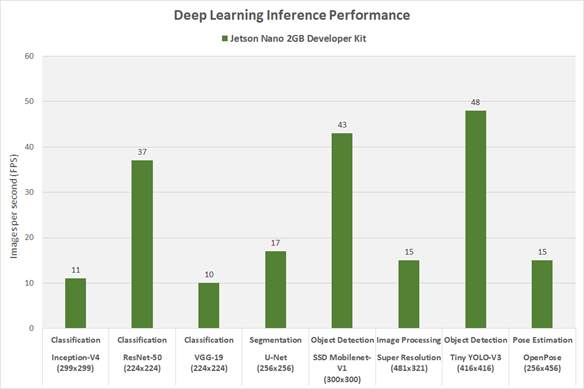Introducing the Ultimate Starter AI Computer, the NVIDIA Jetson Nano 2GB Developer Kit
By Suhas Hariharapura Sheshadri and Dustin Franklin | Tags: CUDA, cuDNN, featured, IoT, Jetson, Jetson Nano, NGC, Robotics
2 Comments
Today, NVIDIA announced the Jetson Nano 2GB Developer Kit, the ideal hands-on platform for teaching, learning, and developing AI and robotics applications. The NVIDIA Jetson platform introduced six years ago revolutionized embedded computing by delivering the power of artificial intelligence to edge computing devices. NVIDIA Jetson today is widely used in diverse fields such as robotics, retail, industrial, agriculture, and AIoT.

In March 2019, NVIDIA launched the original Jetson Nano Developer Kit and enabled developers, students, and enthusiasts alike to learn, explore, and build AI applications for edge devices. Rapid adoption by the enthusiast community made this our most-loved developer kit and created a Jetson movement. The new NVIDIA Jetson Nano 2GB Developer Kit is priced at $59, making it even more affordable for learning AI and robotics. This developer kit is the ultimate starter AI computer and is available worldwide starting at the end of October 2020.
The Jetson Nano 2GB Developer Kit includes a Jetson Nano module with 2 GB memory and delivers 472 GFLOPS of compute performance with a 128-core NVIDIA Maxwell GPU and 64-bit Quad-core Arm A57 CPU. The included carrier board is equipped with interfaces commonly used in edge and embedded project development, including USB 3.0 and USB 2.0 ports to connect peripherals including USB cameras, one MIPI CSI-2 camera connector, a 40-pin header which is compatible out of the box with many peripherals and add-ons, an HDMI display interface, and a Gigabit Ethernet port. The developer kit also includes an 802.11ac wireless networking USB adapter.
| Processing | |
| GPU | 128-core NVIDIA Maxwell™ |
| CPU | 64-bit Quad-core ARM A57 (1.43 GHz) |
| Memory | 2 GB 64-bit LPDDR4 (25.6 GB/s bandwidth) |
| Video Encoder* | 4Kp30 | (4x) 1080p30 | (2x) 1080p60 |
| Video Decoder* | 4Kp60 | (2x) 4Kp30 | (8x) 1080p30 | (4x) 1080p60 |
| Interfaces | |
| Networking | 10/100/1000 Base-T Ethernet |
| Wi-Fi | Available via included 802.11ac wireless adaptor† |
| USB | 1x USB 3.0 Type A port 2x USB 2.0 Type A ports 1x USB 2.0 Micro-B (Device Mode) |
| Display | HDMI |
| 40-Pin Header | GPIOs, I2C, I2S, SPI, PWM, UART |
| Camera | 1x MIPI CSI-2 connector |
| Storage | microSD (Card not included) |
| Other IO | 12-pin header (Power and related signals, UART) 4-pin fan header† |
| Power | USB-C 5V 3A |
Table 1. Jetson Nano 2GB Developer Kit module capabilities and carrier board interfaces.
*Supported video codecs: H.265, H.264, VP8, VP9 (VP9 decode only).
† Not initially available in all regions
Powerful performance
The Jetson Nano 2GB Developer Kit is ideal for learning modern AI. The science of AI computing is changing fast, and researchers are constantly inventing new neural network architectures that deliver better accuracy and performance. AI practitioners today use a wide variety of AI models and frameworks in their projects, so the ideal platform for learning and creating AI projects is one flexible enough to run a diverse set of AI models and also powerful enough to deliver the performance required to create meaningful interactive AI experiences. The Jetson Nano 2GB Developer Kit not only supports all popular AI frameworks and networks, but also delivers a powerful AI performance.
Figure 2 shows the measured AI inference performance with popular DNN models for image classification, segmentation, object detection, image processing, and pose estimation. NVIDIA TensorRT was used to optimize the networks and accelerate inference for real-time performance. The Jetson Nano 2GB Developer Kit is unique in providing such powerful inference performance in this price range.

Ease of use and flexibility to explore
The Jetson Nano 2GB Developer Kit provides the development experience of a ready-to-use platform without putting any limitations on your curiosity to explore AI hands-on with various cameras, sensors, and peripherals. It’s powered by JetPack Software Development Kit (SDK), which includes a familiar Linux desktop development experience. JetPack comes with the libraries required to build end-to-end AI applications. For example, OpenCV and VisionWorks can be used for computer vision and image processing; CUDA, cuDNN, and TensorRT accelerate AI inferencing; and libraries for camera and sensor processing and much more are included.
Unlike cloud-only learning platforms, the developer kit supports many popular sensors in the AI community like Raspberry Pi cameras, Intel Real-sense cameras, the ZED 3D camera, and other USB cameras and peripherals, all working out of the box. JetPack 4.4.1 introduces support for this new developer kit and is available starting at the end of October 2020, aligning with developer kit availability. For more information, see the JetPack page.
You can learn and develop using the AI framework of your choice—frameworks including TensorFlow, PyTorch and MXNet are supported. Development containers for TensorFlow and PyTorch are hosted on NVIDIA NGC, which provide a quick one-step method to get your framework environment up and running. A Jupyter notebook learning environment with preinstalled TensorFlow, PyTorch, NumPy, scikit-learn, SciPy, and pandas is also easily installed on the developer kit using the Machine Learning container, also hosted on NGC.
If you prefer to install frameworks directly rather than using prepackaged containers, NVIDIA provides Python PIP wheels. For more information, see Jetson Zoo.
Developer community
The Jetson developer community is large and vibrant, including researchers, professional developers, AI enthusiasts, students, and hobbyists who are bonded by their passion for AI and the Jetson platform. Thousands of Jetson community members create and actively share cool videos, open-source projects, and real-world AI applications. Best of all, developers share source code and instructions for anyone to try, learn from, and enhance their projects.
NVIDIA regularly shares some favorites on the JetsonTV YouTube channel and on the Jetson Community Projects page. Most of the projects tagged for Jetson Nano can be run on the Jetson Nano 2GB Developer Kit. These are a great approach to exploring and learning AI.https://www.youtube.com/embed/fIESu365Sb0?feature=oembedVideo 1. Jetson community projects running on the Jetson Nano 2GB Developer Kit.
Jetson AI Certification Program
Also today, the NVIDIA Deep Learning Institute launched the Jetson AI Certification Program, The first available course is Jetson AI Fundamentals, which includes a series of hands-on self-paced educational tutorials, video walkthroughs, and project-based assessments aimed at educators and learners. This course builds on popular open-source deep learning and robotics tutorials including Getting Started with AI on Jetson Nano, JetBot, and Hello AI World, and includes new instruction videos created by NVIDIA instructors and community experts.
https://www.youtube.com/embed/videoseries?list=PL5B692fm6–uQRRDTPsJDp4o0xbzkoyf8Video 2. Jetson AI playlist.
The Jetson AI Fundamentals course teaches the foundations of deep learning with classification and regression networks, along with object detection and semantic segmentation. Training and inference workflows, data collection, and real-time computer vision are all covered. The course also includes autonomous robotics topics, and walks through implementation of road following, collision avoidance and object following with the JetBot robot.
The Jetson AI Certification Program covers two certifications:
- Jetson AI Specialist for students, makers, hobbyists, or anyone looking to get started with AI
- Jetson AI Educator for educators and instructors who want to teach AI in their own classes or courses
To obtain certification, participants follow the hands-on Jetson AI Fundamentals course, and then create their own AI project using the concepts they’ve learned throughout the course. Projects are then reviewed by NVIDIA, with feedback provided as necessary.
Discover AI
The Jetson Nano 2GB Developer Kit is a powerful and accessible way for anyone to get started with AI and robotics. It’s great for hands-on learning and you’ll see your work perceive and interact with the world around you in real time. The online Getting Started Guide makes it quick to get up and running with a downloadable system image, and support for popular machine learning frameworks with the NVIDIA CUDA-X stack makes it easy to develop with the same software and tools powering the latest breakthroughs.
Pre-order your Jetson Nano 2GB Developer Kit today and begin your journey discovering AI.About the Authors

About Suhas Hariharapura Sheshadri
Suhas Sheshadri is a product manager at NVIDIA, focusing on Jetson software. He previously worked with the autonomous driving team at NVIDIA, optimizing system software for the NVIDIA Drive platform. In his free time, Suhas likes to read books on quantum physics and game theory.View all posts by Suhas Hariharapura Sheshadri

About Dustin Franklin
Dustin is a developer evangelist on the Jetson team at NVIDIA. With a background in robotics and embedded systems, Dustin enjoys helping in the community and working on projects with Jetson. You can find him on the NVIDIA Developer Forums or GitHub.View all posts by Dustin Franklin Comments
Notable Replies
 sdwarwicksays:October 8, 2020We will need a way of connecting cellular modems, in particular a modem that supports the new 3.5GHz CBRS band to use this part. What will be the best way to get that capability?
sdwarwicksays:October 8, 2020We will need a way of connecting cellular modems, in particular a modem that supports the new 3.5GHz CBRS band to use this part. What will be the best way to get that capability? suhashsays:October 8, 2020There is no out of box suppor for cellular modems. You may need to select the modem you want ( i see some USB modems with CRBS support) and then get the appropriate driver and build it with our kernel.
suhashsays:October 8, 2020There is no out of box suppor for cellular modems. You may need to select the modem you want ( i see some USB modems with CRBS support) and then get the appropriate driver and build it with our kernel.
Continue the discussion at forums.developer.nvidia.com
We received one of the boards to test and review and will report back more on our impressions of the board and its’ capabilities.
